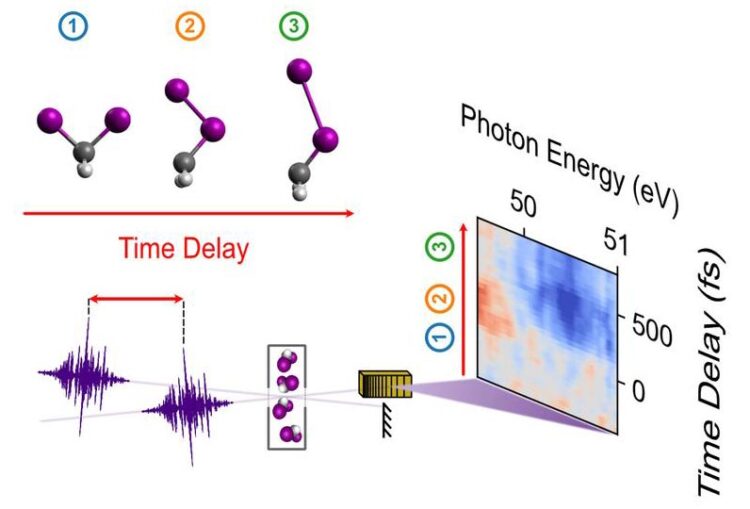Timing molecular structural dynamics…

Sketch of the all-XUV pump-probe time-resolved measurement of the molecular structural dynamics of CH2I2 molecule.
(c) MPIK
– both excited and probed by extreme ultraviolet light…
MPIK physicists of the group around Christian Ott (division of Thomas Pfeifer) demonstrated for the first time an all-XUV (extreme ultraviolet) time-resolved absorption spectroscopy investigation of a small molecule: the photoinduced structural dynamics of diiodomethane. By means of the short wavelength of XUV laser pulses, individual atoms in the molecule can be addressed specifically via a well-defined electronic excitation.
The experiment was performed at the free-electron laser in Hamburg (FLASH), leading a large international collaboration of science teams. Two identical XUV pulses with a variable time delay interact subsequently with an iodine atom of CH2I2 (see Fig. 1). The excitation during the first pulse triggers the dissociation of the molecule, which includes a structural deformation through a short-lived isomeric state (see sketches ①②③). This, in turn, changes the XUV absorption behaviour of CH2I2. which can be analysed via time-dependent spectroscopy with the second XUV pulse.
The change in the absorption signal (red: enhancement, blue: reduction) is clearly visible at a delay of about 200 femtoseconds (fs). This time-resolved information on the transition through the corresponding transient molecular structure ② was extracted by the comparison of experimental spectra with calculations in the theoretical chemistry group of Alexander Kuleff at the Institute of Physical Chemistry, Heidelberg University.
Overall, this is a key step towards using free-electron lasers for time-resolved measurements of moving atoms in molecules (the so-called “molecular movie”). In the future, even larger bandwidths and multi-colour modes will be available to excite and sample different electronic transitions with “local” atom-specific spectroscopic resolution. This also lights the way forward to ultimately control the molecular structure on the fundamental atomic and electronic level.
Wissenschaftliche Ansprechpartner:
Dr. Marc Rebholz
Phone: (+49)6221-516-335
marc.rebholz@mpi-hd.mpg.de
Prof. Dr. Alexander Kuleff
Physikalisch-Chemisches Institut
Universität Heidelberg
Phone: (+49)6221-54-5218
alexander.kuleff@pci.uni-heidelberg.de
Dr. Christian Ott
Phone: (+49)6221-516-577
christian.ott@mpi-hd.mpg.de
Prof. Dr. Thomas Pfeifer
Phone: (+49)6221-516-380
thomas.pfeifer@mpi-hd.mpg.de
Originalpublikation:
All-XUV pump-probe transient absorption spectroscopy of the structural molecular dynamics of di-iodomethane
M. Rebholz, T. Ding, V. Despré, L. Aufleger, M. Hartmann, K. Meyer, V. Stooß, A. Magunia, D. Wachs, P. Birk, Y. Mi, G. Dimitrova Borisova, C. da Costa Castanheira, P. Rupprecht, G. Schmid, K. Schnorr, C. D. Schröter, R. Moshammer, Z.-H. Loh, A. R. Attar, S. R. Leone, T. Gaumnitz, H. J. Wörner, S. Roling, M. Butz, H. Zacharias, S. Düsterer, R. Treusch, G. Brenner, J. Vester, A. I. Kuleff, C. Ott and T. Pfeifer
Phys. Rev. X 11, 031001 (2021). DOI: 10.1103/PhysRevX.11.031001
Media Contact
All latest news from the category: Physics and Astronomy
This area deals with the fundamental laws and building blocks of nature and how they interact, the properties and the behavior of matter, and research into space and time and their structures.
innovations-report provides in-depth reports and articles on subjects such as astrophysics, laser technologies, nuclear, quantum, particle and solid-state physics, nanotechnologies, planetary research and findings (Mars, Venus) and developments related to the Hubble Telescope.
Newest articles

Tackling Life-Threatening Fungal Infections Using RNA Modifications
Importance of RNA modifications for the development of resistance in fungi raises hope for more effective treatment of fungal infections. An often-overlooked mechanism of gene regulation may be involved in…

Unraveling Aphasia: Global Study Breaks Down Patients’ Struggle with Verb Tenses
An international team of researchers, including scientists from the HSE Centre for Language and Brain, has identified the causes of impairments in expressing grammatical tense in people with aphasia. They discovered…

Facing the Storm: A Prepped Up Future Against Extreme Climatic and Weather Changes
From the persistent droughts of southern Africa and Central America in the early part of the year to the more recent devastating extreme rainfall in Spain and the deadly Hurricane…



